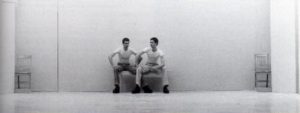Scott Burton was born June 23, 1939 in Greensboro, Alabama. When his parents separated in 1952,  he moved to Washington D.C. with his mother where he studied art with Leon Berkowitz and at Hans Hofmann’s painting school. He attended many universities including Harvard, Columbia, and NYU where he received his bachelor’s in literature and master of fine arts degrees. While the piece of Burton’s work that is present on the Western campus is a sculpture, he didn’t begin sculpting until 1975, just 14 years prior to his death. Rather, Burton began his art career as a critic in 1965 for Art News.
he moved to Washington D.C. with his mother where he studied art with Leon Berkowitz and at Hans Hofmann’s painting school. He attended many universities including Harvard, Columbia, and NYU where he received his bachelor’s in literature and master of fine arts degrees. While the piece of Burton’s work that is present on the Western campus is a sculpture, he didn’t begin sculpting until 1975, just 14 years prior to his death. Rather, Burton began his art career as a critic in 1965 for Art News.
So Burton didn’t enter the art world as a naive sculptor; he had already formulated ideas and opinions on art prior to when he became a contributor. Some ideas included minimalism and making accessible art.
According to Richard Flood, who is currently Chief Curator of the New Museum, Burton really liked his furniture: “The form to which he devoted his greatest concentration was the chair. At first he simply made arrangements of furniture found abandoned on the street” (Flood). However, it is clear that Burton moved on from reimagining found works and began creating the furniture himself, as evidenced by Two-Part Chairs, Right Angle Version. His goal was to dissolve the boundary between art and design, which led to the creation of his sculptures. His work can be found in Seattle, Bellingham, Cincinnati, New York City, Portland, and Toronto.
The two granite chairs at Western are placed in front of the Biology building, where they sit innocuously and unassumingly. Burton became known for these works of art that served as both something aesthetically pleasing and also functional, and the chosen location for Two-Part Chairs, Right Angle Version contributes to this idea. The chairs sit pretty in the shadow of the towering Biology building, yet they are often overlooked and easily forgotten.
The fact that Two-Part Chairs, Right Angle Version are so easily integrated into the daily environment and therefore are forgotten falls right in line with Burton’s ideas of minimalism and accessibility. They never stop being part of the environment and seeing how they are right on either side of the main entrance of the building, the are extremely accessible. Their form is simple and understated, and therefore the minimalist style of Burton causes them to be forgotten.
During the year 1987, many significant events were occurring while Burton was crafting his chairs. Many of these would not have affected his work directly, but some events may have had a subconscious impact. Some events include stock market crashes, Reagan admitting to serious issues with the Iran-Contra affair, and also signed the Intermediate-Range Nuclear Forces Treaty in Washington D.C., a Unabomber attack occurred twice in Salt Lake City, and the AIDS epidemic was at it’s peak.
Despite being a gay man who lived through the 1980’s, an era rich with the gay rights movement and AIDS-related art being produced by the likes of Keith Haring, Burton’s art reflects none of those events. In fact, it seems that Burton’s gay identity was discrete from his art: the most his sexuality influenced his art was through his partner, painter John Button, who introduced him to the social network of the New York’s art world. In the arts, the impact of AIDS was the most visible, especially in New York. Death among young, gay men became eerily familiar. Sadly, Scott Burton died in 1989 at 50 years old in New York City due to AIDS complications, but his work remains timeless.
Bibliography:
Flood, Richard. “Scott Burton.” In Bits & Pieces Put Together to Present a Semblance of a Whole: Walker Art Center Collections, edited by Joan Rothfuss and Elizabeth Carpenter. Minneapolis, MN: Walker Art Center, 2005.
Getsy, David, ed., Scott Burton: Collected Writings on Art and Performance, 1965-1975 (Chicago: Soberscove Press, 2012)
Princethal, Nancy. “High Style, Clear Form, Sharp Edge – Magazine – Art in America”
Smith, Roberta. “Scott Burton, Sculptor Whose Art Verged on Furniture, Is Dead at 50.” The New York Times. The New York Times, 31 Dec. 1989. Web. 26 Apr. 2017.
Walker Art. Scott Burton — Collections — Walker Art Center
Music: We Can’t Be Friends – Dream Koala
Credits:
Caroline May – video, editing, research
Lydia Johnson – video, research
Crystal Gonzalez – video, research, website


Leave a Reply